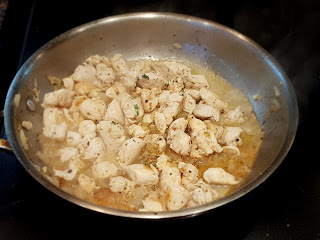This rich but tasty meal was based around a piece of cauliflower and a small piece of blue cheese that were in the fridge....the fact that I had been wanting to make gnocchi for a few weeks inspired the rest of it. It also allowed me to use up some whipping cream, parsley and pinenuts.
Cauliflower and blue cheese are a perfect pairing, the cream sauce carried the flavours and the pinenuts added some crunch. Very filling, incredibly rich but so full of flavour.
Make or buy a batch of potato gnocchi. Have a large pot of salted, boiling water ready while you make the sauce. When the sauce is ready, the water will be ready to cook the gnocchi.
Cut the cauliflower into bite sized pieces; you should have:
2 cups of cauliflower
Using the salted boiling water, blanch the cauliflower for 2 minutes, then remove from the water and drain well. Leave the water on for the gnocchi.
In a hot pan, using some olive oil, cook the blanched cauliflower. Season with salt and pepper.
Keeping the heat high, cook, stirring often, until the cauliflower starts to become golden and crispy.
Remove the cauliflower and set aside.
Turn the heat down to medium low, and add:
1 cup whipping cream
1 Parmesan rind
1 sprig of fresh rosemary
2 cloves fresh garlic
Reduce until the sauce is thick enough to coat the back of a spoon.
Remove the Parmesan, rosemary and garlic cloves.
Whisk in:
1/2 cup crumbled blue cheese
Taste and adjust seasoning.
Turn the sauce down to simmer. Turn the heat down on the boiling water so that it is just above a simmer, and cook the gnocchi.
As the gnocchi cook they will float to the surface of the water. Scoop them out and add them to the sauce, along with:
the reserved cauliflower
Stir gently to coat all the gnocchi and cauliflower with the sauce.
Add:
1/3 cup grated fresh Parmesan
2 tablespoons chopped fresh parsley
Serve, garnished with some lightly toasted pinenuts and a bit of extra crumbled blue cheese.Bon Appetit!
- Blue cheese is great to use with cauliflower, but it as also good to use in a cream sauce as the strong flavoured cheese cuts the richness of the cream. Use cheese such as Stilton, Roquefort or Gorgonzola.
- Goat cheese can be used instead of blue cheese if you like.
- Blanching the cauliflower first gets the cooking off to a head start. You can then finish cooking it quickly, at a high heat to caramelize the natural sugars and crisp the outside, and still have it cooked to perfection...no more than a slight crunch.
- Caramelizing the cauliflower in the pan before adding the cream will bring the cauliflower flavour into the sauce; the Parmesan rind, garlic cloves and rosemary infuse more flavour.
- Season lightly with salt and pepper during each stage of cooking; I find blue cheese can often be on the salty side, so I like to leave the final adjustments to the very end. The saltiness can also intensify as the cream reduces during cooking.
- The sauce can be used with pasta.
- If the sauce reduces too much, add some of the cooking water from the gnocchi to thin it. This water was also used to blanch the cauliflower, so it will add flavour as well as adjust the consistency of the cream sauce.



























































